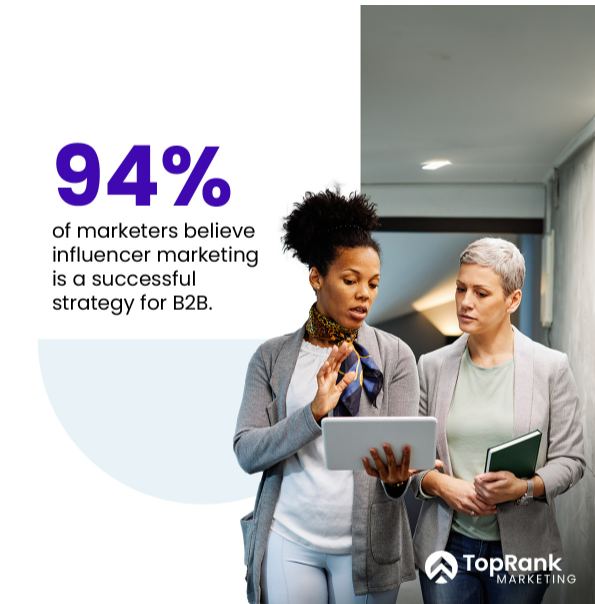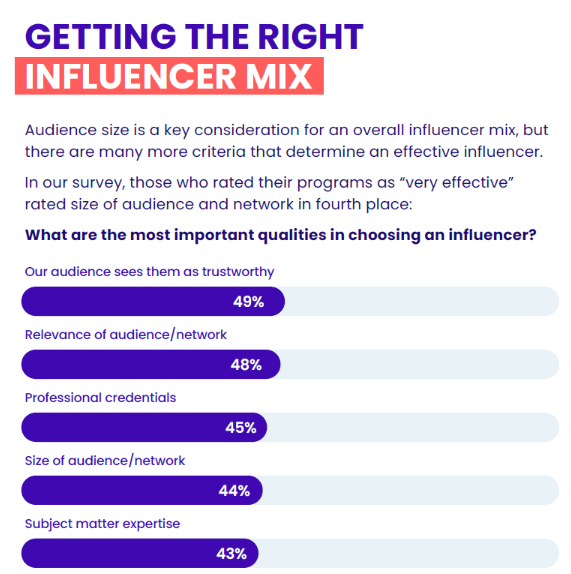Would you pay Justin Bieber to create a video about your company’s SaaS offering? How about contracting Kim Kardashian to produce an Instagram Reel summarizing the highlights of your latest whitepaper? Strategically, it simply makes no sense for enterprise brands to engage with these consumer-friendly faces.
While B2C (business to consumer) marketing and B2B (business to business) marketing share a similar name, the types of influencer programs offered under these categories vary, and the tactical approach couldn’t be more different.
B2B influencer marketing, a strategy of partnering with influential figures in the industry to boost your brand’s reach and credibility, is more prevalent than you think. Perhaps you’re familiar with this campaign by monday.com. Or for a more recent example, take a look at TopRank Marketing’s 2023 B2B Influencer Marketing Report: Elevate & Ignite, a resource fueled by today’s top thought leaders, featuring expert insights and eye-opening statistics like this one: 94% of marketers believe influencer marketing is a successful strategy for B2B marketing.

We know B2B influencer marketing works, but you still may be wondering: how exactly does it… work? Let’s take a look at what goes into crafting an influencer marketing campaign from start to finish.
Step 1: Choosing an influencer marketing program
What type of influencer marketing program is right for your brand: campaign-based or always-on?
Campaign-based: A one-off campaign featuring professional influencers and prospects, while still including customers, industry experts, and niche experts.
- Use cases: You have an in-person event and want to tap into new audiences and drive registrations. You want to test influencers marketing for the first time. Options include, but are not limited to: featuring influencer quotes in an ebook or leveraging an influencer’s audience to drive event registrations.
Always-on: An influencer program with consistent engagement and campaigns.
- Use case: You want to leverage influencers to create evergreen content, supporting product launches and ongoing initiatives.
Both options have their merits; however, our research concluded that marketers who utilized always-on programs saw 10%+ increases in key areas like sales revenue, brand reputation, and brand advocacy over those using a campaign-based approach.
As our own co-founder Lee Odden said, “Engage an influencer for a campaign and they are your friend for the day. Help someone become more influential and they’re your friend for life.”
While there are many things to consider when trying to figure out which program is right for your brand, it usually comes down to two: bandwidth and budget.
Step 2: Conducting a competitive audit
Every successful influencer marketing program begins with a competitive audit. This is where we utilize a combination of SEO and SEM tools, influencer marketing and social media platforms, along with manual searches to identify competitors and uncover strategic insights. Once these methods have been performed, we can provide guidance on how to differentiate, reach underserved audiences, and take advantage of opportunities that may have not been apparent on the surface.
Step 3: Prioritizing influencer qualities and categories
Activating an influencer with a big following means your campaign will be successful! Right? Survey says *audible Family Feud buzzing sound*
While audience size should be a key consideration, marketers who ran “very effective” influencer programs believe audience trustworthiness, audience relevance, and professional credentials are most important. There’s so much to consider, and for this reason, we group B2B influencers into four distinct categories:
- Thought Leaders: Industry experts with large audiences who serve as professional influencers.
- Niche Experts: Topical experts who have a high degree of credibility within a specific group.
- Practitioners: Highly respected people who work in your industry.
- Internal Influencers: Executives and employees with great topical expertise.
The number of influencers in each of the groups taking part in your program will vary based on your overall goal, timeframe, and budget.

Step 4: Identifying and vetting influencers
Discovering influencers who will add value for your campaign can be an arduous task – and we have the data to back it up. Fifty percent of respondents to our survey found it to be the most significant challenge in their influencer marketing programs.
Browsing compiled “top influencer” lists scattered throughout the internet isn’t going to be helpful. To find influencers who provide the right mix of reach, resonance, and relevance, marketers must take a methodical approach that includes the use of tools and manual searches. For example:
Google Boolean Search: We embrace the power of using AND, OR, and NOT to find influencers faster and with more precision.
Influencer Marketing Platforms: Solutions like Klear, Traackr, and Onalytica help streamline the process of identifying and analyzing prospective candidates.
Social Listening Platforms: Meltwater, Sprinklr, and Brandwatch can be used to scour various social media platforms and find influencers who are creating content around your key topics.
LinkedIn/X(formerly known as Twitter) Groups: Manually searching these groups is a great way to find influencers who are providing valuable thought leadership and are active on social media and in their respective communities.
Step 5: Building relationships and outreach
Influencers are the most important part of your campaign – but they don’t have to work with you. And money talks, but they can still walk. This brings us to the importance of building relationships with quality candidates.
How many times have you received a sales email or a message on LinkedIn from a cold contact with boilerplate text? Influencers, especially those in demand, receive the same messages – likely with the same openers.
To get an influencer on board, marketers must offer up more than payment and the opportunity to work with your brand. These thought leaders, much like sales prospects, require nurturing and personalized effort. It’s important to take the time to learn more about them via third-party profiles, reading their work, and engaging with them on social media.
Once equipped with enough information, we recommend sending them a message with a thoughtful opener. Simply let them know you know them.
Step 6: Negotiating
B2B influencers, much like B2C creators, will want to be compensated for their work. Well-established influencers will have a rate sheet you can request to determine what you can afford. Don’t lowball; this isn’t a car dealership. If you feel inclined, give the prospective influencer an idea of your budget. Under the right circumstances, they may be willing to provide a discount of some sort.
After an understanding has been reached, the contract can be drafted and filed away for record-keeping once both parties have signed. And, of course, payment must be handled – which will vary depending on the details of the contract.
Note: The negotiating step provides an excellent opportunity to request benchmarks from the influencer. The benefits of having them are twofold, as they assist in negotiations and give you the ability to grade the influencer post-campaign.
Step 7: Briefing influencers and launching your campaign
Once the influencer has agreed to the work, you will want to provide them with a brief. This will ensure your influencers are set up for success. What’s included in an influencer brief will vary, but should, at the very least, consist of the following:
- Campaign overview and objective
- Key messaging points
- Channels and deliverables
- Social copy
- Relevant links and hashtags.
Finally, once the content is approved, we’ll work with the influencer to determine publishing dates for every single deliverable. We take great care in communicating the launch of every piece of content to ensure the brand can engage and amplify.
Step 8: Report, optimize, and repeat
In our B2B Influencer Marketing Report survey, 93% of respondents said the pressure to prove marketing return on investment (ROI) has increased in the past year, making a comprehensive analysis of your program all the more important.
One-off campaigns are measured upon completion while always-on programs should be reported on a monthly basis.
To understand the effectiveness of your program, we’ll measure results against the benchmarks set previously. But, of course, simply measuring the results isn’t enough. No matter the level of impact, the strategy will need to be optimized to increase its effectiveness, and in turn, the ROI of your program. Take the time to reflect on your goals and ambitions. The success of your next campaign hinges on your ability to implement changes and innovate.
Are you ready for an influencer marketing program?
Influencer marketing programs require a lot of work – so it’s no wonder why so many organizations contract outside agencies to carry out their influencer operations. In fact, our B2B Marketing Report survey found that 70% outsourced their entire program to a B2B influencer marketing agency – and 83% outsourced at least some activities.
We can provide you with greater influencer access and identification insights, relationship-building and nurturing expertise, influencer selection objectivity, content customization, and so much more.
If you’re looking for a trusted partner in the ever-evolving world of influencer marketing, we’re here to help. Contact us today.

Comments are Closed